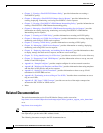
1-3
Cisco IP Solution Center L2VPN and Carrier Ethernet User Guide, 6.0
OL-21636-01
Chapter 1 Getting Started
Setting Up Basic ISC Services
Setting Up the N-PE Loopback Address
Within ISC, you must set the loopback address on the N-PE device(s). For details about this procedure,
see
Setting the Loopback Addresses on N-PE Devices, page 2-2.
Setting Up ISC Resources for L2VPN and VPLS Services
Some ISC resources, such as access domains, VLAN pools, and VC pools are set up to support ISC
L2VPN and VPLS services only. Perform the following steps to set up these resources.
1. Create access domain(s). For L2VPN and VPLS, you create an access domain if you provision an
Ethernet-based service and want ISC to automatically assign a VLAN for the link from the VLAN
pool. For each Layer 2 access domain, you need a corresponding access domain object in ISC.
During creation, you select all the N-PE devices that are associated with this domain. Later, one
VLAN pool can be created for an access domain. For detailed steps to create access domains, see
the
Cisco IP Solution Center Infrastructure Reference, 6.0. See also Creating Access Domains,
page 2-4.
2. Create VLAN pool(s). A VLAN pool is created for each access domain. For L2VPN and VPLS,
you create a VLAN pool so that ISC can assign a VLAN to the links. VLAN ID pools are defined
with a starting value and a size. For detailed steps to create VLAN pools, see the
Cisco IP Solution
Center Infrastructure Reference, 6.0. See also Creating VLAN Pools, page 2-5.
3. Create VC pool(s).VC ID pools are defined with a starting value and a size of the VC ID pool. A
given VC ID pool is not attached to any inventory object (a provider or customer). Create one VC
ID pool per network. For detailed steps to create VC pools, see the
Cisco IP Solution Center
Infrastructure Reference, 6.0. See also Creating a VC ID Pool, page 2-7.
Setting Up NPCs
Before creating an L2VPN or VPLS service request, you must predefine the physical links between CEs
and PEs or between U-PEs and N-PEs. The Named Physical Circuit (NPC) represents a link going
through a group of physical ports. Thus, more than one logical link can be provisioned on the same NPC.
Therefore, the NPC is defined once but used by several L2VPN or VPLS service requests. For detailed
steps to create NPCs, see the
Cisco IP Solution Center Infrastructure Reference, 6.0. See also Creating
Named Physical Circuits, page 2-8.
Setting Up VPNs
You must define VPNs before provisioning L2VPN or VPLS services. In L2VPN, one VPN can be
shared by different service types. In VPLS, one VPN is required for each VPLS instance. To define
VPNs, see the
Cisco IP Solution Center Infrastructure Reference, 6.0. See also Defining VPNs,
page 2-4.


















